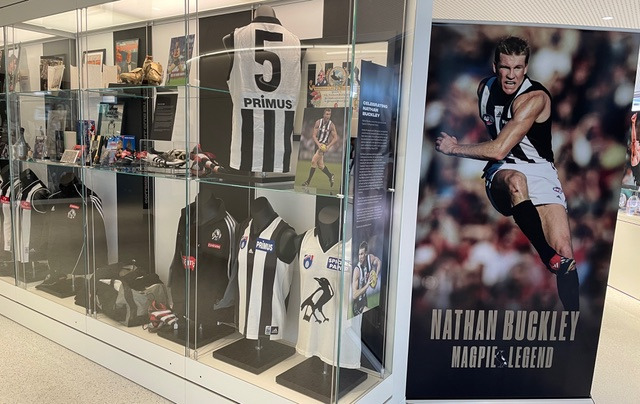

Have a look at Jack Arnott’s wedding photos and there is a familiar face standing alongside him in the wedding party.
It belongs to none other than the great Lou Richards, who was best man at Jack’s wedding. The two had been close mates since childhood, kicking around together on the back streets of Collingwood. As they got older they would go to Saturday night dances at the Collingwood Town Hall, and they also played in premierships together with the Collingwood INF Cricket Club.
And for a brief time it looked like they were going to carry their friendship into their footy careers too. But Jack wasn’t quite as lucky as Lou, and in the end his career was cut cruelly short by a serious illness just as he was making a significant impact at senior level.
 Jack Arnott (far left) and Lou Richards (far right) with the Collingwood INF Cricket Club in 1941-42
Jack Arnott (far left) and Lou Richards (far right) with the Collingwood INF Cricket Club in 1941-42
As far as playing styles go, the two mates couldn’t have been further apart. Jack was a big, strong forward/follower. He spent most of his time at full-forward, but also took spells on the ball. He was tall, powerfully built, had good hands and was a lovely kick of the ball (Lou once told guests at a function that he’d seen Jack kick a goal from such a tight angle that the ball had got stuck between the posts!).
His attempts at forging a VFL career had started in 1939, when he was issued a ‘restricted clearance’ from a club called The Diecasters (which played in the Victorian Junior Football League) to Hawthorn. He’d been playing with Diecasters in 1938 under the former Melbourne and Northcote player Bill Vanthoff, and had made quite a name for himself. He played some practice matches with Hawthorn, and in 1941 played some games with Hawthorn reserves.
In 1942 he was cleared to Collingwood, and it’s reasonable to assume that his friendship with Louie might have had something to do with it.
Jack made his senior VFL debut in the opening round of that 1942 season, kicking a goal against South Melbourne, but played only one further game for the year. In 1943 he added just two more games, and kicked three goals in one of them against Melbourne.
But while he might have struggled for senior game time that year, he dominated the reserves competition. In just nine games he kicked a mighty 51 goals, including six in the first semi-final against South Melbourne. It was enough for him to finish runner-up in the seconds’ best-and-fairest award.
So hopes were high going into the 1944 season. And they soared even higher after he kicked five in one of the last practice matches. The Age said afterwards: “Of the old players Arnott is expected to develop into an ideal full-forward. He leads out well, and was the leading goalkicker of the Seconds.”
He carried that form into the early parts of the season. He kicked four goals in the opening game against North Melbourne, and was even happier when Louie reminded him afterwards that club benefactor John Wren loved a goalkicker and often rewarded big performances with a nice little cash bonus. So the two mates hung around in the rooms long after the game had finished, but there was no sign of Mr Wren. In the end it wasn’t until they were leaving the rooms and had started walking across the ground that Wren appeared, offering a handshake to Jack with 20 pounds inside. The two boys painted the town red that Saturday night.
Jack continued his hot streak with three goals against Fitzroy the next week, then another three against Footscray the week after that. He was held goalless in the fourth round, but even so he had turned plenty of heads in those early weeks. Everything pointed to this being his breakout season.
Sadly, he never played VFL footy again. He became ill with peritonitis soon after that Rd 4 game, and was forced into a wildly premature retirement midway during the year on medical advice. He captained-coached Abbotsford in 1945 (playing alongside his brother Dave, who would later spend many years as a Collingwood recruiter), and then crossed to Prahran in 1946. He would later play with both Mordialloc and Seaford. His son, Steve, played with Collingwood reserves in the 1960s before crossing to Melbourne, where he played one senior game in 1969 before heading to West Perth as part of the famous John Tilbrook deal.
In the end, we’ll never know what Jack Arnott might have been able to do with his career had illness not intervened. He was certainly a serious talent. And it would have been great to watch him and his best mate Louie spend more time together in the black-and-white stripes.
- Michael Roberts
CFC Career Stats
| Season played | Games | Goals | Finals | Win % |
|---|---|---|---|---|
| 1942-1944 | 8 | 14 | 0 | 12.5% |
CFC Season by Season Stats
| Season | GP | GL | B | K | H | T | D | Guernsey No. | ||
|---|---|---|---|---|---|---|---|---|---|---|
Other CFC Games
| Team | League | Years Played | Games | Goals |
|---|---|---|---|---|
| Collingwood | Reserves | 1943 - 1944 | 12 | 51 |
Awards







